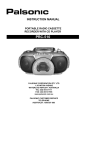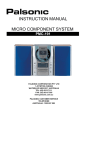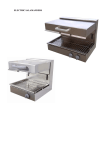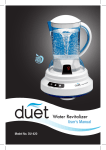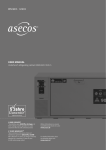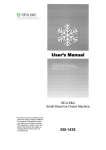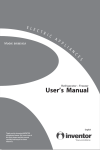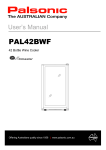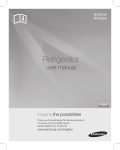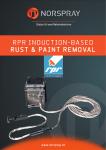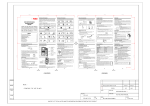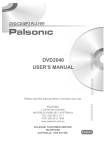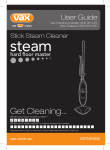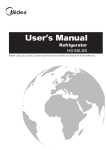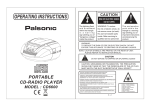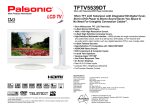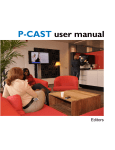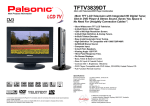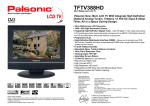Download Instruction Manual
Transcript
User’s Manual PAL50BFZ PAL112BFZ 50 /112 Litre Bar Refrigerator Offering Australians quality since 1958 | www.palsonic.com.au General This type of refrigerator is widely used in places such as hotels, offices, student dormitories and houses. It is mostly suitable for refrigerating and preserving foods such as fruits and beverage. It enjoys the advantages of small size, Lightweight, low electric consumption and easy use. Instructions for Installation 1. Do not tilt the refrigerator for more than 450 from upright during moving it. Do not apply force on any part such as condenser or door to prevent the refrigerator from deforming, or else it will influence its performance. 2. Let the refrigerator have enough space to work well. 3. Don’t install it in an area of high temperature or humidity. This is to avoid it being damaged, dampened and rusted. Cautions for Safety 1. Before the refrigerator is plugged in, please check and make sure the voltage is 240volt the same as the rated voltage. Use the independent socket, of the power plug. An adapter may cause the socket to overheat. 2. Don’t store inflammable materials such as ether, 1 petrol, LP gas and glue etc in the refrigerator. 3. Don’t splash water on the refrigerator; it may cause malfunction or electric shock. 4. If gas leaks from its container. Do not pull the plug out or in as it may arose sparks and fire calamities. Instructions for Use 1. When operating the refrigerator for the first time, run it without loading any food until its auto tops at the desired temperature. Usually it takes 2 or 3hours, then set the thermostatic dial at the setting desired and then load the refrigerator. 2. The temperature of the refrigerator can be adjusted by turning the thermostatic dial. A medium setting of the thermostatic dial is the most suitable for general operation. 3. Defrost the freezing compartment whenever the layer of frost on the surface of the evaporator reaches 3 or 4 mm. When defrosting, remove all food and set the thermostat at “OFF” position. Put the drip tray under the evaporator to collect melted water. After the frost has melted, discard the melted water and dry up the interior of refrigerator. The refrigerator can then be restarted by turning its thermostat to the desired setting. 2 Cautions for Use 1. The more food loaded into the refrigerator or the longer the door is left open increases the electric consumption which may lead to malfunction. 2. It is best not to place items which are too heavy on top of the refigerator. 3. Don’t store bottled drinks in the chiller compartment, so as to prevent from being broken and damaging the refrigerator. 4. Open the door as less as possible during power-cut. 5. When defrosting, never use any sharp or metallic objects to remove the frost on the surface of the evaporator as it will damage the evaporator. 6. Don’t touch foods and containers in the chiller compartment with your wet hands so as to prevent from being stuck to the frost. Maintenance 1. While cleaning the refrigerator, pull out the electric power plug, wipe carefully with a piece of cloth soaked with natural cleanser then wipe with clean water. The abrasive cleaning power, alkali cleansers, chemical cloth, thinner, alcohol, acid petroleum product and hot water are not3 suitable for cleaning the refrigerator, they may damage the paint and plastics. 2. The door seal gets dirty and fogged easily, so clean it frequently. 3. If the refrigerator is out of use for a long time, please pull out the plug, clean and dry the chiller compartment then close the door tightly. The following cases are not malfunction 1. A flowing water sound: Flowing water sound will be heard under normal operation. 2. Outside condensation: Outside condensation is normal in high humidity condition. You may just wipe it up yourself. 3. It takes some times for the temperature of the chiller and refrigerator compartments to become cold after the refrigerator starts to operate: If the temperature of the two compartments is higher while the refrigerator is operating, it takes some times for the temperature of the two compartments to become cold. If the environmental temperature is higher, it takes a long time to make the compartments to become cold. 4. The surface of the compressor becomes hot: The surface of the compressor may become hot under normal operation. Don’t touch it with 4 hands. Methods of inspecting malfunction If any case of malfunction happens, please inspect and correct it according to the methods shown in the following table. Inspection case Not refrigerating Not Cold enough Is there no electric current? Is the voltage normal or not? Has the socket fused? Has the plug been put in effectively? Is the thermostatic dial set to the correct position? Is there any suitable clearance surrounding the refrigerator? Has the door been opened too frequently or too long? Is the refrigerator exposed to sunlight directly or placed near some heating devices. Is there too much food inside? Or is the food too hot? 5 Food frozen in the refrigerator Compartment Is the thermostatic dial set to the correct position? Have the foods stuff been put too crowded? Noises Is the refrigerator installed firmly? Has the refrigerator been struck by some other objects? Are the foods stored too much at Compressor one setting? Cannot stop automatically Are the doors opened too frequently or too long? If the above methods are not yet corrected, please contact the manufacterer for assistance without any delay. RECOMMENDATIONS 1) WARNING – Keep ventilation openings, in the appliance enclosure or in the built-in structure, clear of obstruction. 2) WARNING – Do not use mechanical devices or other means to accelerate the defrosting process, other than those recommended by the manufacturer. 6 3) WARNING – Do not damage the refrigerant circuit. 4) WARNING – Do not use electrical appliances inside the food storage compartments of the appliance, unless they are of the type recommended by the manufacturer. 5) The appliance has to be unplugged after use and before carrying out user maintenance on the appliance. 6) This appliance is not intended for use by persons (including children) with reduced physical, sensory or mental capabilities, or lack of experience and knowledge, unless they have been given supervision or instruction concerning use of the appliance by a person responsible for their safety. 7) Children should be supervised to ensure that they do not play with the appliance. 8) If the supply cord is damaged, it must be replaced by the manufacturer, its service agent or similarly qualified persons in order to avoid a hazard. 7 Palsonic Customer Service Telephone (Australia) 1300 657 888 Palsonic Corporation Pty Ltd ABN 34 000 474 108 1 Joynton Avenue, Waterloo NSW 2017 Australia Telephone (02) 9313 7111 Facsimile (02) 9697 0655 www.palsonic.com.au









